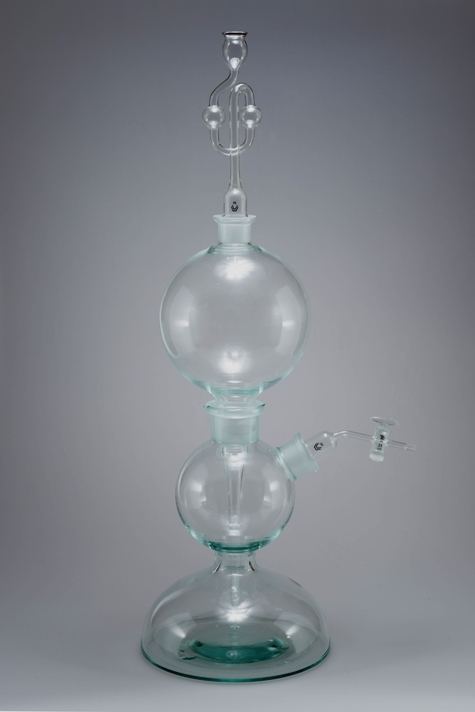 | ||
Kipp's apparatus, also called Kipp generator, is an apparatus designed for preparation of small volumes of gases. It was invented around 1844 by the Dutch pharmacist Petrus Jacobus Kipp and widely used in chemical laboratories and for demonstrations in schools into the second half of the 20th century.
Contents
- Design and operation
- Examples for prepared gases and their educts
- Further gas treatments
- Variants
- References
It later fell out of use, at least in laboratories, because most gases then became available in small gas cylinders. These industrial gases are much purer and drier than those initially obtained from a Kipp apparatus without further processing.
Design and operation
The apparatus is usually made of glass, or sometimes of polyethylene, and consists of three vertically stacked chambers, roughly resembling a snowman. The upper chamber extends downward as a tube that passes through the middle chamber into the lower chamber. There is no direct path between the middle and upper chambers, but the middle chamber is separated from the lower chamber by a retention plate, such as a conical piece of glass with small holes, which permits the passage of liquid and gas. The solid material (e.g., iron sulfide) is placed into the middle chamber in lumps sufficiently large to avoid falling through the retention plate. The liquid, such as an acid, is poured into the top chamber. Although the acid is free to flow down through the tube into the bottom chamber, it is prevented from rising there by the pressure of the gas contained above it, which is able to leave the apparatus only by a stopcock near the top of the middle chamber. This stopcock may be opened, initially to permit the air to leave the apparatus, allowing the liquid in the bottom chamber to rise through the retention plate into the middle chamber and react with the solid material. Gas is evolved from this reaction, which may be drawn off through the stopcock as desired. When the stopcock is closed, the pressure of the evolved gas in the middle chamber rises and pushes the acid back down into the bottom chamber, until it is not in contact with the solid material anymore. At that point the chemical reaction comes to a stop, until the stopcock is opened again and more gas is drawn off.
Kipp generators only work properly in the described manner if the solid material is insoluble in the acid, as otherwise the dissolved material would continue to evolve gas even after the level dropped. The produced gas often requires further purification and/or drying, due to content of water vapor and possibly mist if the reaction is vigorous.
Examples for prepared gases and their educts
For successful use in a Kipp's apparatus, the solid material has to be available in lumps large enough to stay on the retention plate without falling through its holes.
Generally, weak acidic gases can be released from their metal salts by dilute acids, and sometimes just with water:
A version of the apparatus can be used for reaction between two liquid precursors. A mercury trap has to be added as a check valve, and the middle bulb is filled with an inert porous material, e.g. pumice, onto which one of the precursors is dropped.
Further gas treatments
The prepared gas is usually impure, contaminated with fine aerosol of the reagents and water vapor. The gases may need to be filtered, washed and dried before further use.
Hydrogen can be washed from sulfane, arsine and oxygen with subsequent bubbling through solutions of lead acetate, silver nitrate, and alkaline pyrogallic acid.
Acidic gases (e.g. hydrogen sulfide, hydrogen chloride, sulfur dioxide) can be dried with concentrated sulfuric acid, or with phosphorus pentoxide. Basic gases (e.g. ammonia) can be dried with calcium oxide, sodium hydroxide or soda lime.
Disposal of the gases can be done by burning the flammable ones (carbon monoxide, hydrogen, hydrocarbons), absorbing them in water (ammonia, hydrogen sulfide, sulfur dioxide, chlorine), or reacting them with a suitable reagent.
Variants
Many variants of the gas production apparatus exist. Some are suitable for production of larger amounts of gases (Gay-Lussac and Verkhovsky), some for smaller amounts (Kiryushkin, U-tube).
A Döbereiner's lamp is a small modified Kipp's apparatus for production of hydrogen. The hydrogen is led over a platinum sponge catalyst, where it reacts with air oxygen, heats the catalyst and ignites from it, producing a gentle flame. It was commercialized for lighting fires and pipes. It's said that in 1820s over a million of the "tinderboxes" ("Feuerzeug") was sold.
